Shallots vs. Onions: What’s the Difference?
By Dr. Malavika Athavale +2 more

Get,

to manage your symptom
Get your,


4 Cr+ families
benefitted

OTP sent to 9988776655



You’ve successfully subscribed to receive
doctor-approved tips on
Whatsapp

Get ready to feel your best.

Hi There,
Download the PharmEasy App now!!


Register to Avail the Offer
Send OTPBy continuing, you agree with our Privacy Policy and Terms and Conditions

Hi There,
Sign up on PharmEasy now!!
Trusted by 4 crore+ families

OTP sent to 9988776655



You have unlocked 25% off on medicines




Code: NU25
By Dr. Malavika Athavale +2 more
Table of Contents
Shallots and onions are common allium veggies. They share the same family and similar tastes. Yet, they differ in many ways. These differences are in their looks, uses in cooking, and nutrient content. Wouldn’t you like to know more? Our goal here is to offer a clear-cut comparison of shallots and onions. In turn, this will help you understand their unique qualities. To begin with, we will take a closer look at their sources and types. We will also cover their nutritional values, uses in cooking and potential health benefits and guide you on making dishes using these vegetables. So, let us get started.
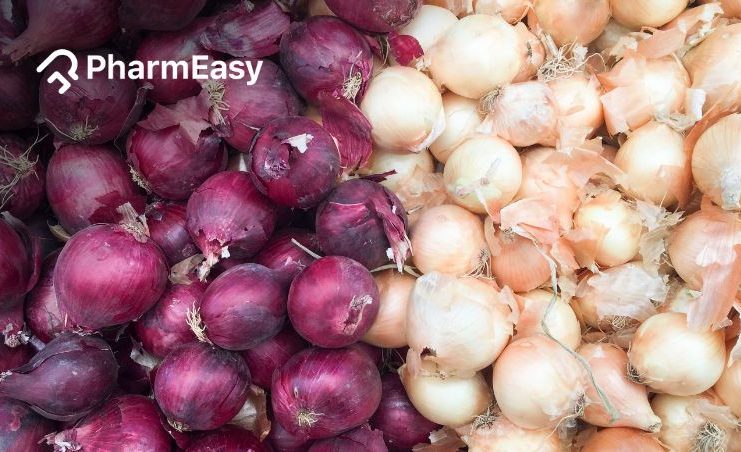
First things first, let us understand the lesser-known shallot. Not as well-known as the onion, the shallot has its own charm and adds a delightful taste to various dishes. Sounds interesting, doesn’t it?
Shallots hail from the southern and southeast parts of Asia. They grow in small bunches within the leaf’s base. There are three main types of shallots2.
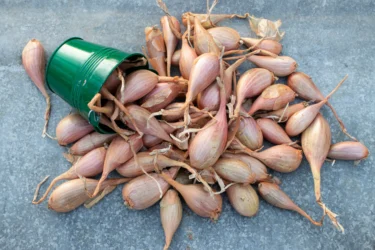
Also called French shallots, grey shallots have a silver-grey skin. They give off an intense, uniquely sweet flavour. They are smaller and are often used in special dishes for their distinctive taste.
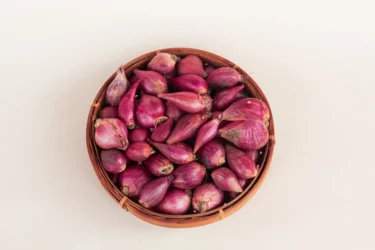
Red shallots get their name from their reddish or rose-coloured skin. They are usually larger than grey shallots. Their taste is mild and a bit sweeter than other types. That is why they are a versatile ingredient for many recipes.
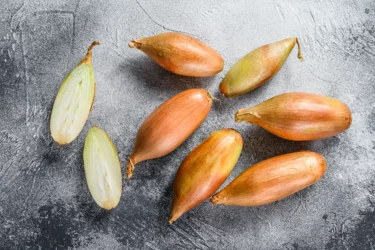
Dutch yellow shallots stand out for their large size and long shape. They have a tan-coloured skin with a mildly sweet flavour. They are perfect for many different types of dishes.
Shallots are generally smaller than onions and are longer in shape. They have finer layers and carry less water. Their colour can range from grey to soft purple or brown.
Shallots are less strong and sweeter than onions. This makes them suitable for dishes that need a light, delicate flavour.
Now that we have got shallots covered, let us move on to the more widespread veggie – the onion. Onions are an essential ingredient in kitchens throughout the world. Their unique flavour and versatility make them popular in diverse cuisines.
Onions belong to the same Allium family as shallots. There are three main varieties of onions:
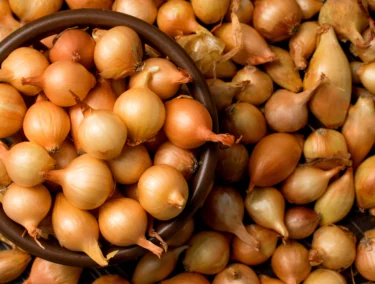
Yellow onions are the most common type of onions used. They have a yellow-brown skin and have a robust, slightly sweet flavour when cooked. Yellow onions are great for roasting, frying, or sautéing.
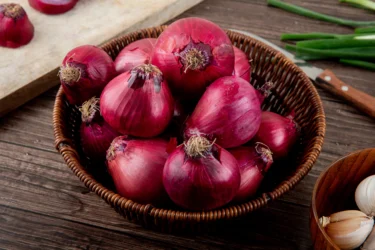
Red onions are known for their deep violet skin and layered white and red insides. They taste milder than yellow onions. That is why they are well-liked in salads and sandwiches, especially when raw.
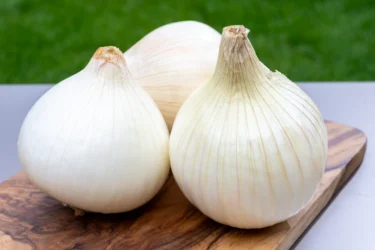
White onions have pure white skin and inner layers. With a somewhat sweeter taste than yellow onions, white onions have a crisp texture. These onions are ideal for salsas, guacamoles, and other cold dishes.
Onions are usually round. Their dry, papery outer skin covers several ring-like layers. You can find them in various sizes, from tiny pearls to the size of a softball.
Onions taste more potent than shallots. However, their taste may change based on the specific kind. For example, red onions are milder than yellow onions. In contrast, white onions are somewhat sweeter than the rest.
In my opinion, onions go beyond being a mere flavouring agent for dishes. Onions might be low in calories and virtually fat-free, making them a potential nutritious choice. Additionally, they contain various healthful components that may have the potential to ward off inflammation in arthritis and related conditions10
Dr. Smita Barode, B.A.M.S, M.S.
We have discussed both shallots and onions in depth. Now, let us focus on the noteworthy differences between these two members of the Allium family.
Onions are round and bulb shaped. They have a papery skin and multiple ring-like layers. Shallots, on the other hand, are smaller, longer, and grow in clusters. They have finer layers than onions.
Shallots taste milder and sweeter than onions. That makes them a great fit for recipes that need a fine taste. Onions, however, are more robust. They provide a potent flavour that changes based on the variety (yellow, red, or white).
Shallots have less water than onions. This makes them a bit harder when raw. Thanks to their texture, they withstand certain kinds of recipes better. Examples are salads or dressings where a crunchy texture might be sought.
Onions are more common and cost-effective. Meanwhile, shallots can be pricier and not so customary in regular grocery stores.
Although both belong to the Allium family, shallots and onions exhibit notable differences in their nutrient content. Recognising these differences will help you maximise healthy nutrients in your cooking.
Your healthcare provider may suggest incorporating shallots and onions into your diet for their antioxidant properties.
From what I have read, studies suggest that shallots and onions contain certain compounds that may help reduce type I allergies. These compounds, known as quercetin 4’-glucoside and quercetin 3, 4’-diglucoside, have been found to possibly inhibit allergic reactions. This means that including shallots or onions along with prescribed medications may help bring down allergic symptoms11.
Dr. Siddharth Gupta, B.A.M.S, M.D (Ayu)
As discussed earlier, shallots and onions play many different roles in cooking. Knowing their best uses will help you make the most of these delicious veggies in your dishes.
The fine, subtly sweet taste of shallots makes them ideal for salad dressings, sauces, and vinaigrettes. You can pickle, caramelise, or roast shallots. You can also add them to soups, pasta, casseroles, and side dishes as a garnish.
Onions offer a wide range of uses in cooking. Different types add unique flavours and textures. As mentioned earlier, yellow onions work well for roasting, frying, and sautéing. Red onions lend a fine, sweet touch to cold dishes, like salads and sandwiches. White onions taste especially good in salsas and guacamole.
At times, you can switch shallots and onions in recipes. However, you need to account for taste and size differences. If you are using shallots instead of onions in raw dishes, think about using a milder onion variant, such as Vidalia, or use less quantity.
Despite their differences, shallots and onions both may provide many health benefits, possibly due to their rich nutrient and antioxidant content.
Based on my years of experience and the findings of several studies, I may say that shallots possess antimicrobial properties. These properties make shallots potentially effective in the management of dermatomycosis (fungal skin infections) and other infectious diseases6.
Dr. Rajeev Singh, BAMS
Although, both shallots and onions have been found to contain nutrients that are beneficial for health, more large-scale human studies need to be done to confirm these benefits.
Keeping shallots and onions fresh calls for proper storage. By using the right storage methods, these vegetables can stay fresh for long and retain their taste and texture for a longer duration.
By being aware of the differences and nuances between shallots and onions, you can make more informed choices. Consider the flavour, nutrition, and desired results of your dishes when using these versatile allium veggies. Remember, understanding your ingredients better equips you to create tasty recipes suited to your preferences and needs.
Chefs tend to go for shallots due to their fine, sweet, and delicate flavour. This makes shallots a great choice in dishes that need gentle flavours like salad dressings, sauces, and vinaigrettes.
Go for shallots when a recipe calls for a lighter, subtler flavour. For example, in salad dressings, sauces, and vinaigrettes. If you replace onions with shallots in certain recipes, the final dish’s flavour may change.
You can certainly grow both shallots and onions at home! They just need the right growing conditions. With well-draining, nutrient-rich soil and ample sunlight, you can successfully grow your own shallots and onions.
Some recipes may specifically demand either shallots or onions due to their unique flavour profiles and textures. For instance, shallots can be used in recipes like beef bourguignon, coq au vin, and warm spinach salad with bacon and shallot vinaigrette.Go for onions in dishes like French onion soup, caramelised onion tart, chopped Greek salad, fajitas and Indian curries.
If you cannot find shallots, consider replacing them with onions. Keep in mind, that onions have a stronger flavour. Maybe use less onion or choose a milder variant, like Vidalia. That way, you can achieve a somewhat similar taste.
Disclaimer: The information provided here is for educational/awareness purposes only and is not intended to be a substitute for medical treatment by a healthcare professional and should not be relied upon to diagnose or treat any medical condition. The reader should consult a registered medical practitioner to determine the appropriateness of the information and before consuming any medication. PharmEasy does not provide any guarantee or warranty (express or implied) regarding the accuracy, adequacy, completeness, legality, reliability or usefulness of the information; and disclaims any liability arising thereof.
Links and product recommendations in the information provided here are advertisements of third-party products available on the website. PharmEasy does not make any representation on the accuracy or suitability of such products/services. Advertisements do not influence the editorial decisions or content. The information in this blog is subject to change without notice. The authors and administrators reserve the right to modify, add, or remove
Comments

Leave your comment...
You may also like
Comments